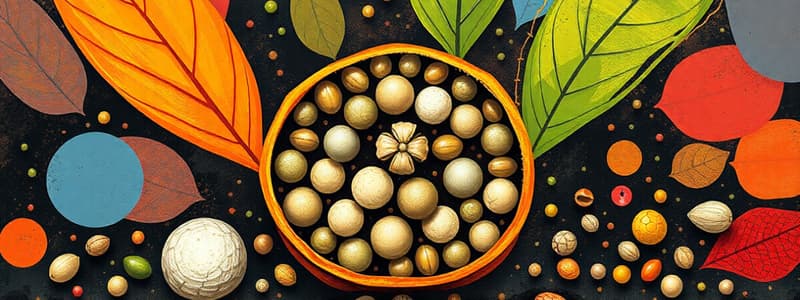Podcast
Questions and Answers
What is the main function of the seed coat?
What is the main function of the seed coat?
- Protects the seed (correct)
- Food supply for the embryo
- Facilitates germination
- Absorbs water
Which type of seeds can tolerate desiccation?
Which type of seeds can tolerate desiccation?
- Dicot seeds
- Monocot seeds
- Recalcitrant seeds
- Orthodox seeds (correct)
What is the process of sowing seeds called?
What is the process of sowing seeds called?
- Transplanting
- Storage
- Germination
- Sowing (correct)
Which factor is NOT essential for seed germination?
Which factor is NOT essential for seed germination?
What conditions are ideal for seed storage?
What conditions are ideal for seed storage?
What is the general rule for planting seed depth?
What is the general rule for planting seed depth?
What is the purpose of labeling the sowing site?
What is the purpose of labeling the sowing site?
What is a characteristic of monocot seeds?
What is a characteristic of monocot seeds?
Flashcards are hidden until you start studying
Study Notes
Seed
- Definition: A seed is a small, hard, dry plant structure that contains an embryo and the nutrients necessary for initial growth.
- Structure:
- Seed coat: protects the seed.
- Endosperm: food supply for the embryo.
- Embryo: the developing plant that will grow into a new plant.
- Types of seeds:
- Orthodox seeds: Can tolerate some desiccation and are viable after drying and storage.
- Recalcitrant seeds: Do not survive drying and need to be stored in moist conditions.
Seed Types
- Monocot seeds: one cotyledon; examples include grasses and lilies.
- Dicot seeds: two cotyledons; examples include beans and sunflowers.
Sowing
- Definition: The act of planting seeds in soil or other growth mediums for germination.
- Timing:
- Optimal sowing time varies by species, climate, and planting zone.
- Methods of sowing:
- Direct sowing: Planting seeds directly in their final growing location.
- Transplanting: Sowing seeds in a controlled environment (like seed trays) before moving them to the garden.
Seed Germination
- Process: The transition of a seed to a seedling; involves imbibition (water absorption), activation of metabolism, and emergence of the shoot and root.
- Factors affecting germination:
- Moisture: Essential for seed activation.
- Temperature: Each species has an optimal temperature range.
- Oxygen: Important for respiration during germination.
- Light: Some seeds require light to germinate, while others germinate better in darkness.
Seed Storage
- Importance: Proper seed storage extends seed viability and ensures successful planting in the future.
- Conditions for storage:
- Cool, dry, and dark environments are ideal.
- Airtight containers can prevent moisture and pest damage.
Best Practices for Sowing
- Seed depth: General rule is to plant at a depth of 2 to 3 times the seed's diameter.
- Spacing: Ensure adequate spacing for the mature plant size to avoid competition.
- Watering: Lightly water the area after sowing to settle soil around the seeds without displacing them.
- Labeling: Mark the sowing site with the type of seed and date of sowing for future reference.
Seed Structure
- Consists of a seed coat for protection, endosperm for food, and an embryo for plant development.
- Seed coat: protects the seed from damage and drying out.
- Endosperm: provides nourishment for the developing embryo.
- Embryo: contains the genetic information needed for the new plant to grow.
Seed Types
- Orthodox seeds: can be dried and stored for long periods.
- Recalcitrant seeds: cannot tolerate drying and require storage in moist conditions.
- Monocot seeds: single cotyledon, examples include grasses and lilies.
- Dicot seeds: two cotyledons, examples include beans and sunflowers.
Sowing
- Refers to the planting of seeds in soil or other growth mediums.
- Direct sowing: planting seeds directly into their final growing location.
- Transplanting: sowing seeds in a controlled environment and then moving them to the garden.
- Timing: depends on species, climate, and planting zone.
Seed Germination
- The transition from a seed to a seedling involving:
- Imbibition: water absorption
- Activation of metabolism
- Emergence of shoot and root
- Factors affecting germination:
- Moisture: essential for a seed to break dormancy
- Temperature: optimal temperature varies by species.
- Oxygen: needed for respiration during germination.
- Light: Some seeds require light to germinate, while others germinate better in darkness.
Seed Storage
- Importance: Proper storage extends the lifespan of a seed and improves the chances of successful germination.
- Conditions: cool, dry, and dark environments are ideal.
- Containers: airtight containers help prevent moisture and pest damage.
Best Practices for Sowing
- Seed Depth: Plant seeds at a depth of 2-3 times the seed's diameter.
- Spacing: Allow adequate spacing for the mature plant size.
- Watering: Lightly water the area after sowing to help the seed settle.
- Labeling: Mark the sowing site with the type of seed and date of sowing.
Studying That Suits You
Use AI to generate personalized quizzes and flashcards to suit your learning preferences.




